Regional Expansion: A Case Study of Town and County Services Project
VerifiedAdded on 2023/06/03
|11
|2823
|334
Case Study
AI Summary
This document presents a practical demonstration and analysis related to Town and County Services' regional expansion project. It includes an email invitation to stakeholders for a meeting focused on risk management, the meeting's agenda, and detailed minutes covering communication of the risk management process, risk identification and analysis, and discussion of unidentified technological risks. Key discussion points included the four stages of risk management (establishment of risk context, scoping, stakeholder identification, and analysis), PESTEL and SWOT analyses, and specific risks such as insurance, customer dissatisfaction, water spillage, and electrical hazards. The minutes further detail the proposed risk management strategies, including the use of risk assessment tables, risk management plans, and action plans, along with assigned responsibilities for managing identified risks. The case study highlights the importance of stakeholder support and continuous risk management evaluation, emphasizing the need to address potential technological risks for the successful implementation of the expansion project. Desklib provides access to similar documents and study resources for students.
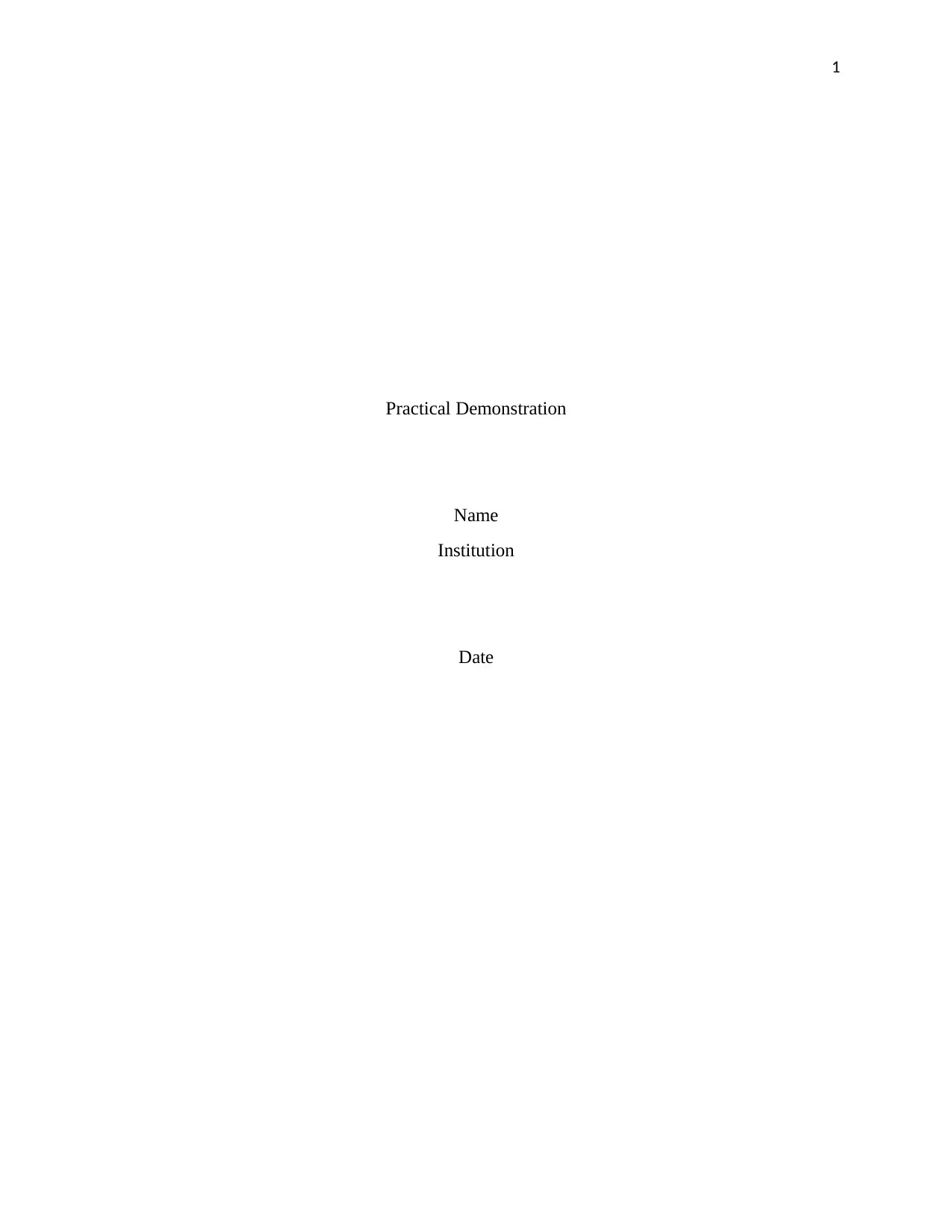
1
Practical Demonstration
Name
Institution
Date
Practical Demonstration
Name
Institution
Date
Paraphrase This Document
Need a fresh take? Get an instant paraphrase of this document with our AI Paraphraser
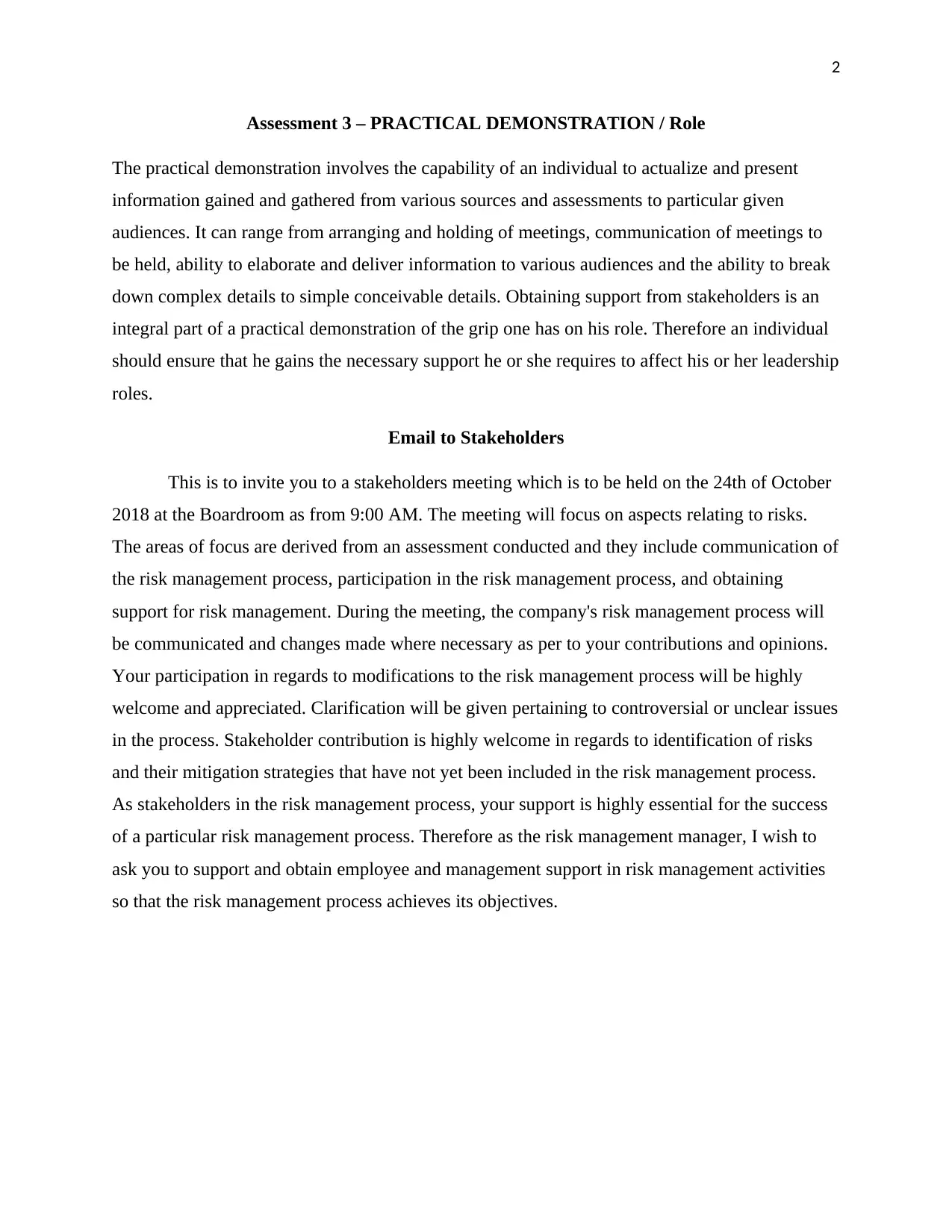
2
Assessment 3 – PRACTICAL DEMONSTRATION / Role
The practical demonstration involves the capability of an individual to actualize and present
information gained and gathered from various sources and assessments to particular given
audiences. It can range from arranging and holding of meetings, communication of meetings to
be held, ability to elaborate and deliver information to various audiences and the ability to break
down complex details to simple conceivable details. Obtaining support from stakeholders is an
integral part of a practical demonstration of the grip one has on his role. Therefore an individual
should ensure that he gains the necessary support he or she requires to affect his or her leadership
roles.
Email to Stakeholders
This is to invite you to a stakeholders meeting which is to be held on the 24th of October
2018 at the Boardroom as from 9:00 AM. The meeting will focus on aspects relating to risks.
The areas of focus are derived from an assessment conducted and they include communication of
the risk management process, participation in the risk management process, and obtaining
support for risk management. During the meeting, the company's risk management process will
be communicated and changes made where necessary as per to your contributions and opinions.
Your participation in regards to modifications to the risk management process will be highly
welcome and appreciated. Clarification will be given pertaining to controversial or unclear issues
in the process. Stakeholder contribution is highly welcome in regards to identification of risks
and their mitigation strategies that have not yet been included in the risk management process.
As stakeholders in the risk management process, your support is highly essential for the success
of a particular risk management process. Therefore as the risk management manager, I wish to
ask you to support and obtain employee and management support in risk management activities
so that the risk management process achieves its objectives.
Assessment 3 – PRACTICAL DEMONSTRATION / Role
The practical demonstration involves the capability of an individual to actualize and present
information gained and gathered from various sources and assessments to particular given
audiences. It can range from arranging and holding of meetings, communication of meetings to
be held, ability to elaborate and deliver information to various audiences and the ability to break
down complex details to simple conceivable details. Obtaining support from stakeholders is an
integral part of a practical demonstration of the grip one has on his role. Therefore an individual
should ensure that he gains the necessary support he or she requires to affect his or her leadership
roles.
Email to Stakeholders
This is to invite you to a stakeholders meeting which is to be held on the 24th of October
2018 at the Boardroom as from 9:00 AM. The meeting will focus on aspects relating to risks.
The areas of focus are derived from an assessment conducted and they include communication of
the risk management process, participation in the risk management process, and obtaining
support for risk management. During the meeting, the company's risk management process will
be communicated and changes made where necessary as per to your contributions and opinions.
Your participation in regards to modifications to the risk management process will be highly
welcome and appreciated. Clarification will be given pertaining to controversial or unclear issues
in the process. Stakeholder contribution is highly welcome in regards to identification of risks
and their mitigation strategies that have not yet been included in the risk management process.
As stakeholders in the risk management process, your support is highly essential for the success
of a particular risk management process. Therefore as the risk management manager, I wish to
ask you to support and obtain employee and management support in risk management activities
so that the risk management process achieves its objectives.
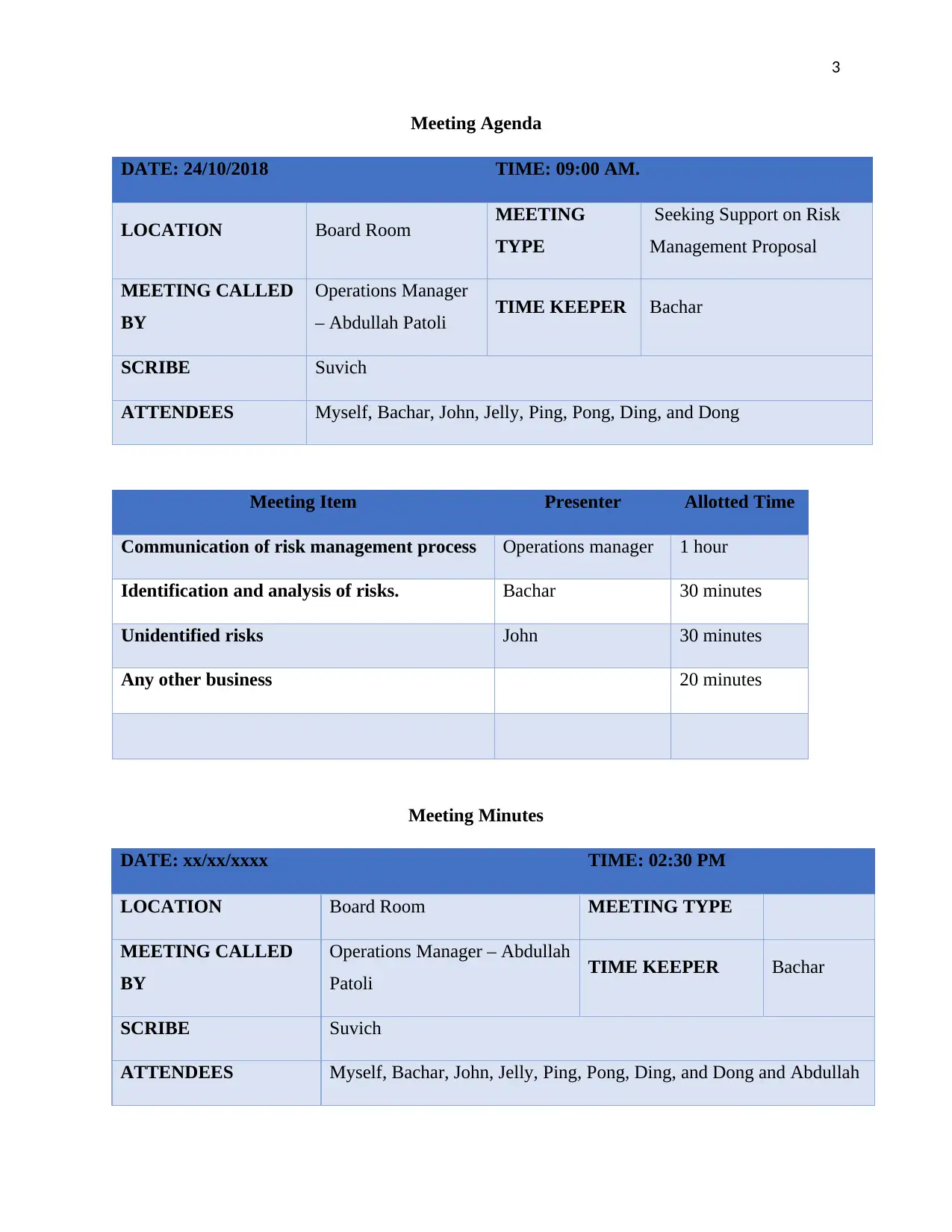
3
Meeting Agenda
DATE: 24/10/2018 TIME: 09:00 AM.
LOCATION Board Room MEETING
TYPE
Seeking Support on Risk
Management Proposal
MEETING CALLED
BY
Operations Manager
– Abdullah Patoli TIME KEEPER Bachar
SCRIBE Suvich
ATTENDEES Myself, Bachar, John, Jelly, Ping, Pong, Ding, and Dong
Meeting Item Presenter Allotted Time
Communication of risk management process Operations manager 1 hour
Identification and analysis of risks. Bachar 30 minutes
Unidentified risks John 30 minutes
Any other business 20 minutes
Meeting Minutes
DATE: xx/xx/xxxx TIME: 02:30 PM
LOCATION Board Room MEETING TYPE
MEETING CALLED
BY
Operations Manager – Abdullah
Patoli TIME KEEPER Bachar
SCRIBE Suvich
ATTENDEES Myself, Bachar, John, Jelly, Ping, Pong, Ding, and Dong and Abdullah
Meeting Agenda
DATE: 24/10/2018 TIME: 09:00 AM.
LOCATION Board Room MEETING
TYPE
Seeking Support on Risk
Management Proposal
MEETING CALLED
BY
Operations Manager
– Abdullah Patoli TIME KEEPER Bachar
SCRIBE Suvich
ATTENDEES Myself, Bachar, John, Jelly, Ping, Pong, Ding, and Dong
Meeting Item Presenter Allotted Time
Communication of risk management process Operations manager 1 hour
Identification and analysis of risks. Bachar 30 minutes
Unidentified risks John 30 minutes
Any other business 20 minutes
Meeting Minutes
DATE: xx/xx/xxxx TIME: 02:30 PM
LOCATION Board Room MEETING TYPE
MEETING CALLED
BY
Operations Manager – Abdullah
Patoli TIME KEEPER Bachar
SCRIBE Suvich
ATTENDEES Myself, Bachar, John, Jelly, Ping, Pong, Ding, and Dong and Abdullah
⊘ This is a preview!⊘
Do you want full access?
Subscribe today to unlock all pages.

Trusted by 1+ million students worldwide

4
Patoli (Operations Manager)
OTHER PRESENT Stakeholders Jonathan and Kim
ABSENTEES Stakeholders Joyce and Obrian
MAIN POINTS DISCUSSED
Communication of Risk Management Process
The risk management process was brought into perspective by the operations manager
Mr. Abdullah Patoli. He brought into perspective the various aspects that revolve around risks
affecting the organization and implementation and actualization of various organizational
projects. He brought into perspective that the risk management process adopted by the company
is divided into four stages which each has different roles to play in the whole process (Zisa,
2011). The four stages include the establishment of risk context and identification of risks,
scoping, identification of stakeholders and their roles in the process, and analysis.
He went further to bring into perspective what each stage is all about. From his
presentation establishment of the risk context and identification of risks is the first and essential
stage of the risk management process. It involves the identification of the context. The context
here refers to the subject organization or the organization likely to be affected by risks. It can
revolve around industry, trends, and regions. He brought into perspective that risks are factors
that are likely to cause an unpleasant effect on project implementation and as a result hinder
achievement of projects goals and objectives (Hillson, 2012). In understanding the context
PESTEL analysis was employed in where the political, economic, social, technological,
environmental and legal aspects that affect the company were evaluated.
Scoping entails the identification of project goals and objectives. By so doing one is able
to identify the risks that are most likely to affect the project and how to mitigate those risks. Here
he brought into perspective project goals such as technological innovations, new products and
Patoli (Operations Manager)
OTHER PRESENT Stakeholders Jonathan and Kim
ABSENTEES Stakeholders Joyce and Obrian
MAIN POINTS DISCUSSED
Communication of Risk Management Process
The risk management process was brought into perspective by the operations manager
Mr. Abdullah Patoli. He brought into perspective the various aspects that revolve around risks
affecting the organization and implementation and actualization of various organizational
projects. He brought into perspective that the risk management process adopted by the company
is divided into four stages which each has different roles to play in the whole process (Zisa,
2011). The four stages include the establishment of risk context and identification of risks,
scoping, identification of stakeholders and their roles in the process, and analysis.
He went further to bring into perspective what each stage is all about. From his
presentation establishment of the risk context and identification of risks is the first and essential
stage of the risk management process. It involves the identification of the context. The context
here refers to the subject organization or the organization likely to be affected by risks. It can
revolve around industry, trends, and regions. He brought into perspective that risks are factors
that are likely to cause an unpleasant effect on project implementation and as a result hinder
achievement of projects goals and objectives (Hillson, 2012). In understanding the context
PESTEL analysis was employed in where the political, economic, social, technological,
environmental and legal aspects that affect the company were evaluated.
Scoping entails the identification of project goals and objectives. By so doing one is able
to identify the risks that are most likely to affect the project and how to mitigate those risks. Here
he brought into perspective project goals such as technological innovations, new products and
Paraphrase This Document
Need a fresh take? Get an instant paraphrase of this document with our AI Paraphraser
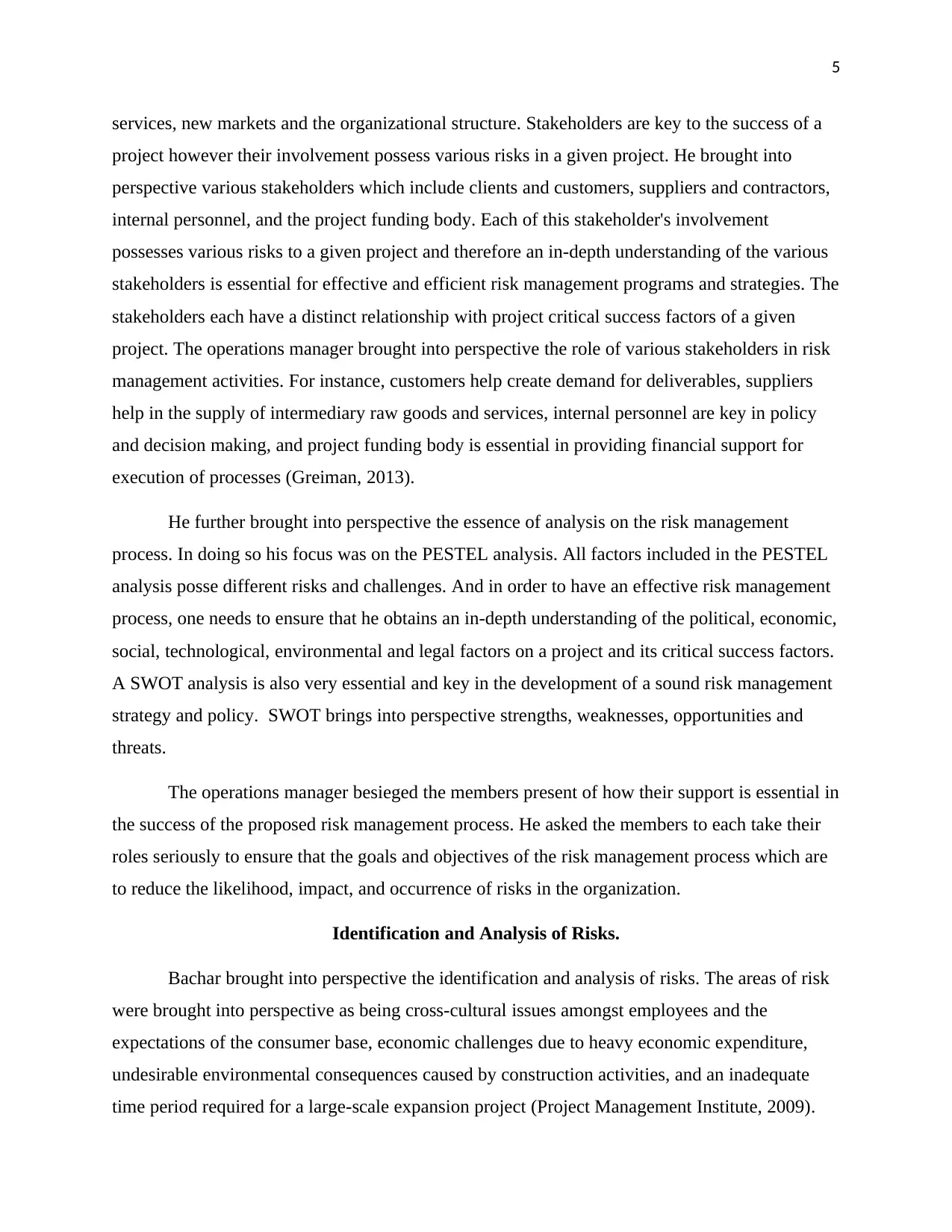
5
services, new markets and the organizational structure. Stakeholders are key to the success of a
project however their involvement possess various risks in a given project. He brought into
perspective various stakeholders which include clients and customers, suppliers and contractors,
internal personnel, and the project funding body. Each of this stakeholder's involvement
possesses various risks to a given project and therefore an in-depth understanding of the various
stakeholders is essential for effective and efficient risk management programs and strategies. The
stakeholders each have a distinct relationship with project critical success factors of a given
project. The operations manager brought into perspective the role of various stakeholders in risk
management activities. For instance, customers help create demand for deliverables, suppliers
help in the supply of intermediary raw goods and services, internal personnel are key in policy
and decision making, and project funding body is essential in providing financial support for
execution of processes (Greiman, 2013).
He further brought into perspective the essence of analysis on the risk management
process. In doing so his focus was on the PESTEL analysis. All factors included in the PESTEL
analysis posse different risks and challenges. And in order to have an effective risk management
process, one needs to ensure that he obtains an in-depth understanding of the political, economic,
social, technological, environmental and legal factors on a project and its critical success factors.
A SWOT analysis is also very essential and key in the development of a sound risk management
strategy and policy. SWOT brings into perspective strengths, weaknesses, opportunities and
threats.
The operations manager besieged the members present of how their support is essential in
the success of the proposed risk management process. He asked the members to each take their
roles seriously to ensure that the goals and objectives of the risk management process which are
to reduce the likelihood, impact, and occurrence of risks in the organization.
Identification and Analysis of Risks.
Bachar brought into perspective the identification and analysis of risks. The areas of risk
were brought into perspective as being cross-cultural issues amongst employees and the
expectations of the consumer base, economic challenges due to heavy economic expenditure,
undesirable environmental consequences caused by construction activities, and an inadequate
time period required for a large-scale expansion project (Project Management Institute, 2009).
services, new markets and the organizational structure. Stakeholders are key to the success of a
project however their involvement possess various risks in a given project. He brought into
perspective various stakeholders which include clients and customers, suppliers and contractors,
internal personnel, and the project funding body. Each of this stakeholder's involvement
possesses various risks to a given project and therefore an in-depth understanding of the various
stakeholders is essential for effective and efficient risk management programs and strategies. The
stakeholders each have a distinct relationship with project critical success factors of a given
project. The operations manager brought into perspective the role of various stakeholders in risk
management activities. For instance, customers help create demand for deliverables, suppliers
help in the supply of intermediary raw goods and services, internal personnel are key in policy
and decision making, and project funding body is essential in providing financial support for
execution of processes (Greiman, 2013).
He further brought into perspective the essence of analysis on the risk management
process. In doing so his focus was on the PESTEL analysis. All factors included in the PESTEL
analysis posse different risks and challenges. And in order to have an effective risk management
process, one needs to ensure that he obtains an in-depth understanding of the political, economic,
social, technological, environmental and legal factors on a project and its critical success factors.
A SWOT analysis is also very essential and key in the development of a sound risk management
strategy and policy. SWOT brings into perspective strengths, weaknesses, opportunities and
threats.
The operations manager besieged the members present of how their support is essential in
the success of the proposed risk management process. He asked the members to each take their
roles seriously to ensure that the goals and objectives of the risk management process which are
to reduce the likelihood, impact, and occurrence of risks in the organization.
Identification and Analysis of Risks.
Bachar brought into perspective the identification and analysis of risks. The areas of risk
were brought into perspective as being cross-cultural issues amongst employees and the
expectations of the consumer base, economic challenges due to heavy economic expenditure,
undesirable environmental consequences caused by construction activities, and an inadequate
time period required for a large-scale expansion project (Project Management Institute, 2009).
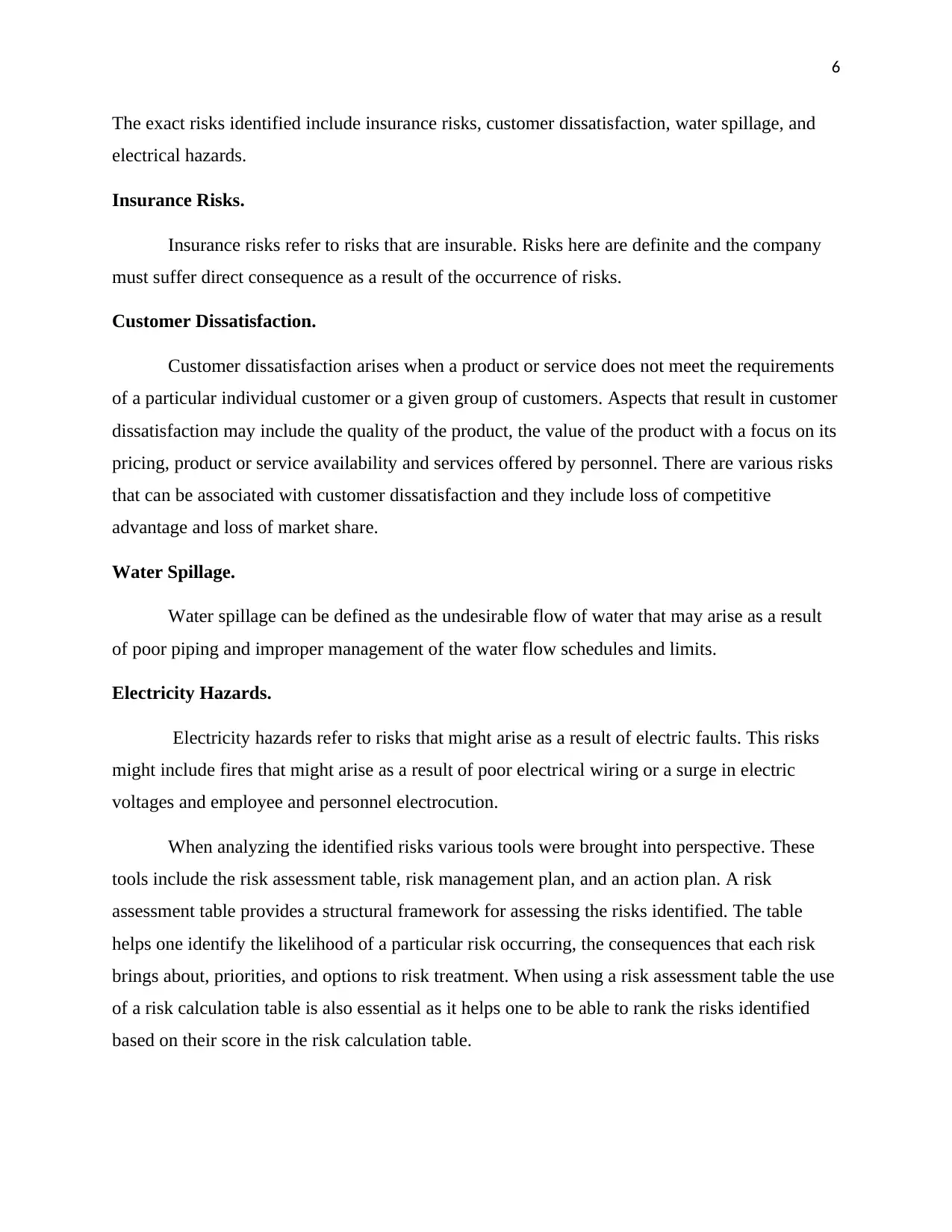
6
The exact risks identified include insurance risks, customer dissatisfaction, water spillage, and
electrical hazards.
Insurance Risks.
Insurance risks refer to risks that are insurable. Risks here are definite and the company
must suffer direct consequence as a result of the occurrence of risks.
Customer Dissatisfaction.
Customer dissatisfaction arises when a product or service does not meet the requirements
of a particular individual customer or a given group of customers. Aspects that result in customer
dissatisfaction may include the quality of the product, the value of the product with a focus on its
pricing, product or service availability and services offered by personnel. There are various risks
that can be associated with customer dissatisfaction and they include loss of competitive
advantage and loss of market share.
Water Spillage.
Water spillage can be defined as the undesirable flow of water that may arise as a result
of poor piping and improper management of the water flow schedules and limits.
Electricity Hazards.
Electricity hazards refer to risks that might arise as a result of electric faults. This risks
might include fires that might arise as a result of poor electrical wiring or a surge in electric
voltages and employee and personnel electrocution.
When analyzing the identified risks various tools were brought into perspective. These
tools include the risk assessment table, risk management plan, and an action plan. A risk
assessment table provides a structural framework for assessing the risks identified. The table
helps one identify the likelihood of a particular risk occurring, the consequences that each risk
brings about, priorities, and options to risk treatment. When using a risk assessment table the use
of a risk calculation table is also essential as it helps one to be able to rank the risks identified
based on their score in the risk calculation table.
The exact risks identified include insurance risks, customer dissatisfaction, water spillage, and
electrical hazards.
Insurance Risks.
Insurance risks refer to risks that are insurable. Risks here are definite and the company
must suffer direct consequence as a result of the occurrence of risks.
Customer Dissatisfaction.
Customer dissatisfaction arises when a product or service does not meet the requirements
of a particular individual customer or a given group of customers. Aspects that result in customer
dissatisfaction may include the quality of the product, the value of the product with a focus on its
pricing, product or service availability and services offered by personnel. There are various risks
that can be associated with customer dissatisfaction and they include loss of competitive
advantage and loss of market share.
Water Spillage.
Water spillage can be defined as the undesirable flow of water that may arise as a result
of poor piping and improper management of the water flow schedules and limits.
Electricity Hazards.
Electricity hazards refer to risks that might arise as a result of electric faults. This risks
might include fires that might arise as a result of poor electrical wiring or a surge in electric
voltages and employee and personnel electrocution.
When analyzing the identified risks various tools were brought into perspective. These
tools include the risk assessment table, risk management plan, and an action plan. A risk
assessment table provides a structural framework for assessing the risks identified. The table
helps one identify the likelihood of a particular risk occurring, the consequences that each risk
brings about, priorities, and options to risk treatment. When using a risk assessment table the use
of a risk calculation table is also essential as it helps one to be able to rank the risks identified
based on their score in the risk calculation table.
⊘ This is a preview!⊘
Do you want full access?
Subscribe today to unlock all pages.

Trusted by 1+ million students worldwide
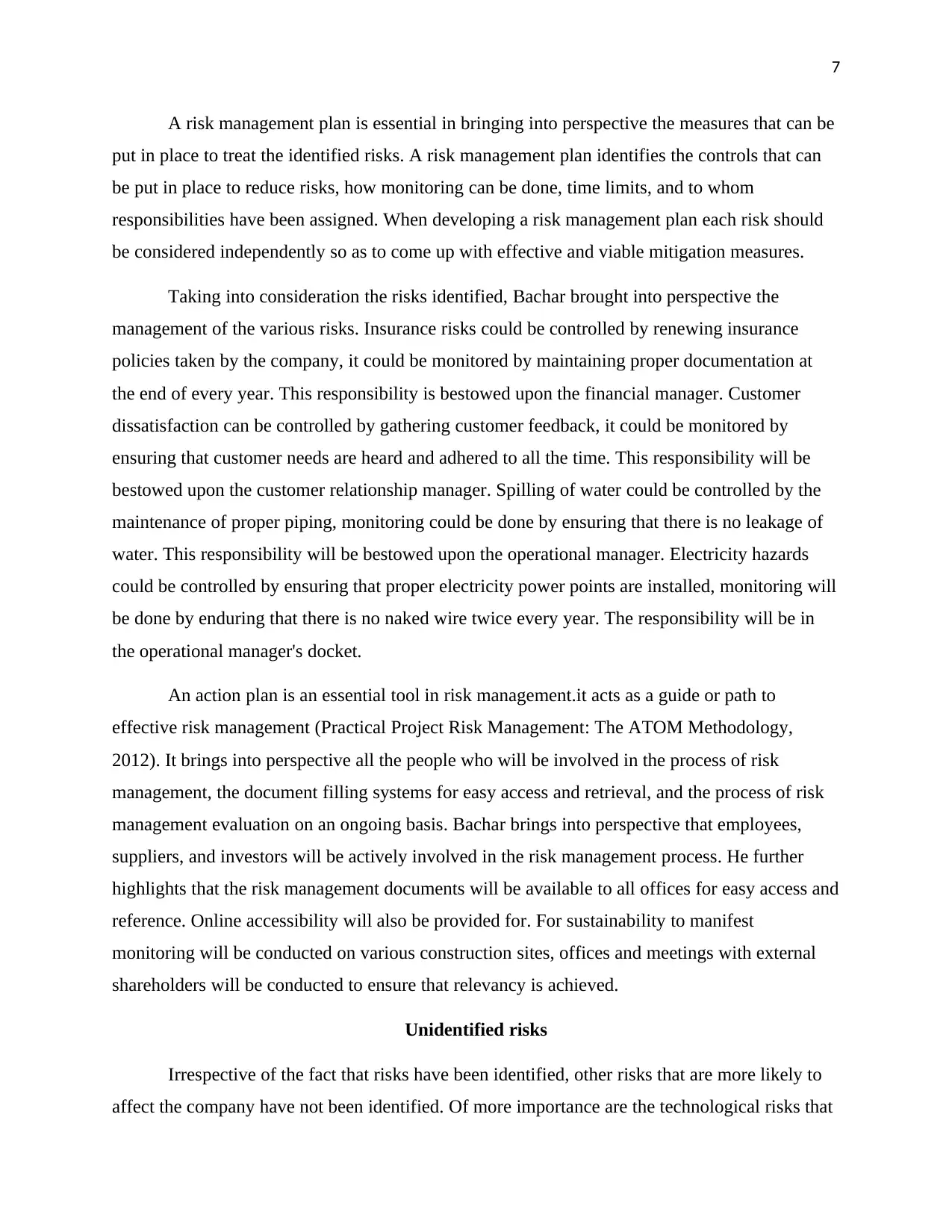
7
A risk management plan is essential in bringing into perspective the measures that can be
put in place to treat the identified risks. A risk management plan identifies the controls that can
be put in place to reduce risks, how monitoring can be done, time limits, and to whom
responsibilities have been assigned. When developing a risk management plan each risk should
be considered independently so as to come up with effective and viable mitigation measures.
Taking into consideration the risks identified, Bachar brought into perspective the
management of the various risks. Insurance risks could be controlled by renewing insurance
policies taken by the company, it could be monitored by maintaining proper documentation at
the end of every year. This responsibility is bestowed upon the financial manager. Customer
dissatisfaction can be controlled by gathering customer feedback, it could be monitored by
ensuring that customer needs are heard and adhered to all the time. This responsibility will be
bestowed upon the customer relationship manager. Spilling of water could be controlled by the
maintenance of proper piping, monitoring could be done by ensuring that there is no leakage of
water. This responsibility will be bestowed upon the operational manager. Electricity hazards
could be controlled by ensuring that proper electricity power points are installed, monitoring will
be done by enduring that there is no naked wire twice every year. The responsibility will be in
the operational manager's docket.
An action plan is an essential tool in risk management.it acts as a guide or path to
effective risk management (Practical Project Risk Management: The ATOM Methodology,
2012). It brings into perspective all the people who will be involved in the process of risk
management, the document filling systems for easy access and retrieval, and the process of risk
management evaluation on an ongoing basis. Bachar brings into perspective that employees,
suppliers, and investors will be actively involved in the risk management process. He further
highlights that the risk management documents will be available to all offices for easy access and
reference. Online accessibility will also be provided for. For sustainability to manifest
monitoring will be conducted on various construction sites, offices and meetings with external
shareholders will be conducted to ensure that relevancy is achieved.
Unidentified risks
Irrespective of the fact that risks have been identified, other risks that are more likely to
affect the company have not been identified. Of more importance are the technological risks that
A risk management plan is essential in bringing into perspective the measures that can be
put in place to treat the identified risks. A risk management plan identifies the controls that can
be put in place to reduce risks, how monitoring can be done, time limits, and to whom
responsibilities have been assigned. When developing a risk management plan each risk should
be considered independently so as to come up with effective and viable mitigation measures.
Taking into consideration the risks identified, Bachar brought into perspective the
management of the various risks. Insurance risks could be controlled by renewing insurance
policies taken by the company, it could be monitored by maintaining proper documentation at
the end of every year. This responsibility is bestowed upon the financial manager. Customer
dissatisfaction can be controlled by gathering customer feedback, it could be monitored by
ensuring that customer needs are heard and adhered to all the time. This responsibility will be
bestowed upon the customer relationship manager. Spilling of water could be controlled by the
maintenance of proper piping, monitoring could be done by ensuring that there is no leakage of
water. This responsibility will be bestowed upon the operational manager. Electricity hazards
could be controlled by ensuring that proper electricity power points are installed, monitoring will
be done by enduring that there is no naked wire twice every year. The responsibility will be in
the operational manager's docket.
An action plan is an essential tool in risk management.it acts as a guide or path to
effective risk management (Practical Project Risk Management: The ATOM Methodology,
2012). It brings into perspective all the people who will be involved in the process of risk
management, the document filling systems for easy access and retrieval, and the process of risk
management evaluation on an ongoing basis. Bachar brings into perspective that employees,
suppliers, and investors will be actively involved in the risk management process. He further
highlights that the risk management documents will be available to all offices for easy access and
reference. Online accessibility will also be provided for. For sustainability to manifest
monitoring will be conducted on various construction sites, offices and meetings with external
shareholders will be conducted to ensure that relevancy is achieved.
Unidentified risks
Irrespective of the fact that risks have been identified, other risks that are more likely to
affect the company have not been identified. Of more importance are the technological risks that
Paraphrase This Document
Need a fresh take? Get an instant paraphrase of this document with our AI Paraphraser
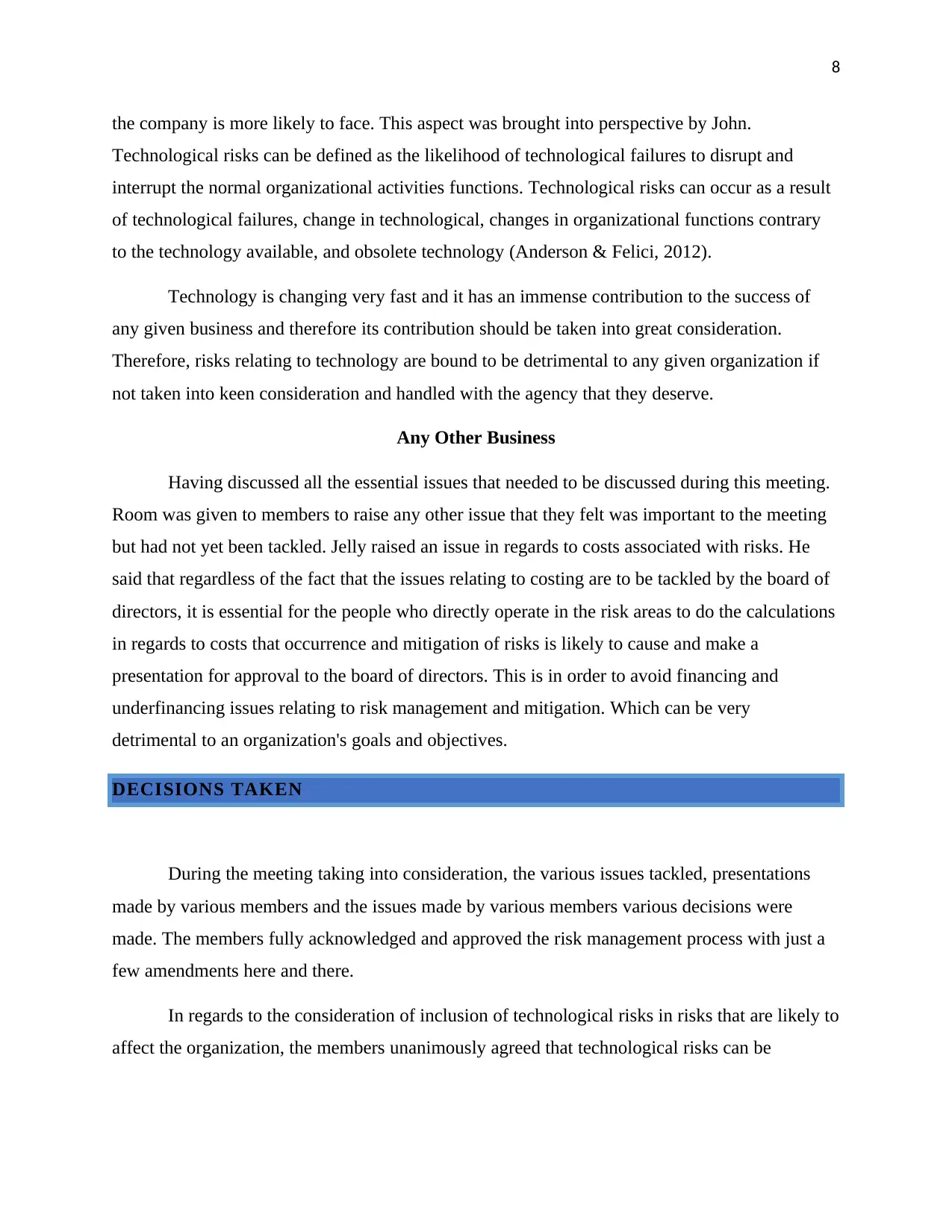
8
the company is more likely to face. This aspect was brought into perspective by John.
Technological risks can be defined as the likelihood of technological failures to disrupt and
interrupt the normal organizational activities functions. Technological risks can occur as a result
of technological failures, change in technological, changes in organizational functions contrary
to the technology available, and obsolete technology (Anderson & Felici, 2012).
Technology is changing very fast and it has an immense contribution to the success of
any given business and therefore its contribution should be taken into great consideration.
Therefore, risks relating to technology are bound to be detrimental to any given organization if
not taken into keen consideration and handled with the agency that they deserve.
Any Other Business
Having discussed all the essential issues that needed to be discussed during this meeting.
Room was given to members to raise any other issue that they felt was important to the meeting
but had not yet been tackled. Jelly raised an issue in regards to costs associated with risks. He
said that regardless of the fact that the issues relating to costing are to be tackled by the board of
directors, it is essential for the people who directly operate in the risk areas to do the calculations
in regards to costs that occurrence and mitigation of risks is likely to cause and make a
presentation for approval to the board of directors. This is in order to avoid financing and
underfinancing issues relating to risk management and mitigation. Which can be very
detrimental to an organization's goals and objectives.
DECISIONS TAKEN
During the meeting taking into consideration, the various issues tackled, presentations
made by various members and the issues made by various members various decisions were
made. The members fully acknowledged and approved the risk management process with just a
few amendments here and there.
In regards to the consideration of inclusion of technological risks in risks that are likely to
affect the organization, the members unanimously agreed that technological risks can be
the company is more likely to face. This aspect was brought into perspective by John.
Technological risks can be defined as the likelihood of technological failures to disrupt and
interrupt the normal organizational activities functions. Technological risks can occur as a result
of technological failures, change in technological, changes in organizational functions contrary
to the technology available, and obsolete technology (Anderson & Felici, 2012).
Technology is changing very fast and it has an immense contribution to the success of
any given business and therefore its contribution should be taken into great consideration.
Therefore, risks relating to technology are bound to be detrimental to any given organization if
not taken into keen consideration and handled with the agency that they deserve.
Any Other Business
Having discussed all the essential issues that needed to be discussed during this meeting.
Room was given to members to raise any other issue that they felt was important to the meeting
but had not yet been tackled. Jelly raised an issue in regards to costs associated with risks. He
said that regardless of the fact that the issues relating to costing are to be tackled by the board of
directors, it is essential for the people who directly operate in the risk areas to do the calculations
in regards to costs that occurrence and mitigation of risks is likely to cause and make a
presentation for approval to the board of directors. This is in order to avoid financing and
underfinancing issues relating to risk management and mitigation. Which can be very
detrimental to an organization's goals and objectives.
DECISIONS TAKEN
During the meeting taking into consideration, the various issues tackled, presentations
made by various members and the issues made by various members various decisions were
made. The members fully acknowledged and approved the risk management process with just a
few amendments here and there.
In regards to the consideration of inclusion of technological risks in risks that are likely to
affect the organization, the members unanimously agreed that technological risks can be
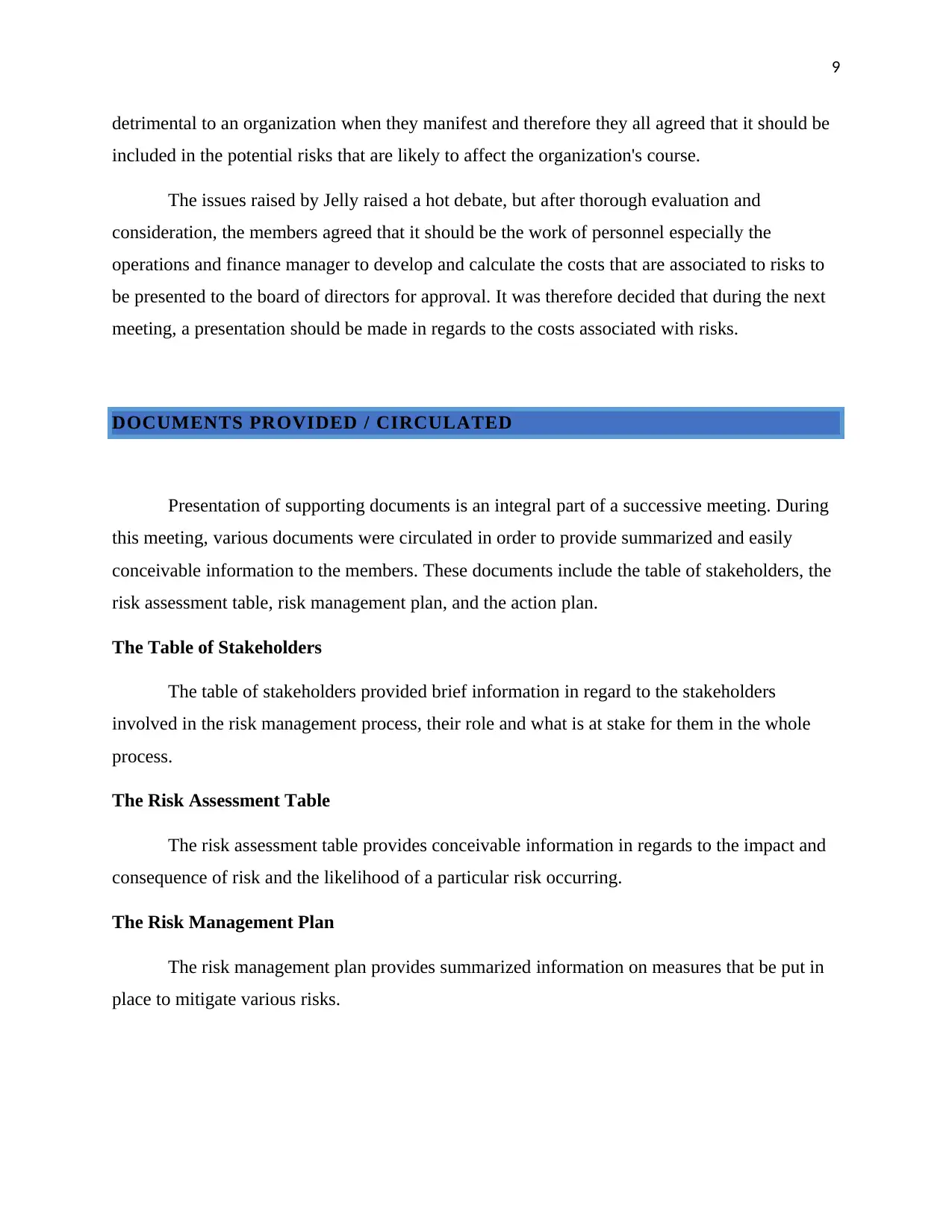
9
detrimental to an organization when they manifest and therefore they all agreed that it should be
included in the potential risks that are likely to affect the organization's course.
The issues raised by Jelly raised a hot debate, but after thorough evaluation and
consideration, the members agreed that it should be the work of personnel especially the
operations and finance manager to develop and calculate the costs that are associated to risks to
be presented to the board of directors for approval. It was therefore decided that during the next
meeting, a presentation should be made in regards to the costs associated with risks.
DOCUMENTS PROVIDED / CIRCULATED
Presentation of supporting documents is an integral part of a successive meeting. During
this meeting, various documents were circulated in order to provide summarized and easily
conceivable information to the members. These documents include the table of stakeholders, the
risk assessment table, risk management plan, and the action plan.
The Table of Stakeholders
The table of stakeholders provided brief information in regard to the stakeholders
involved in the risk management process, their role and what is at stake for them in the whole
process.
The Risk Assessment Table
The risk assessment table provides conceivable information in regards to the impact and
consequence of risk and the likelihood of a particular risk occurring.
The Risk Management Plan
The risk management plan provides summarized information on measures that be put in
place to mitigate various risks.
detrimental to an organization when they manifest and therefore they all agreed that it should be
included in the potential risks that are likely to affect the organization's course.
The issues raised by Jelly raised a hot debate, but after thorough evaluation and
consideration, the members agreed that it should be the work of personnel especially the
operations and finance manager to develop and calculate the costs that are associated to risks to
be presented to the board of directors for approval. It was therefore decided that during the next
meeting, a presentation should be made in regards to the costs associated with risks.
DOCUMENTS PROVIDED / CIRCULATED
Presentation of supporting documents is an integral part of a successive meeting. During
this meeting, various documents were circulated in order to provide summarized and easily
conceivable information to the members. These documents include the table of stakeholders, the
risk assessment table, risk management plan, and the action plan.
The Table of Stakeholders
The table of stakeholders provided brief information in regard to the stakeholders
involved in the risk management process, their role and what is at stake for them in the whole
process.
The Risk Assessment Table
The risk assessment table provides conceivable information in regards to the impact and
consequence of risk and the likelihood of a particular risk occurring.
The Risk Management Plan
The risk management plan provides summarized information on measures that be put in
place to mitigate various risks.
⊘ This is a preview!⊘
Do you want full access?
Subscribe today to unlock all pages.

Trusted by 1+ million students worldwide
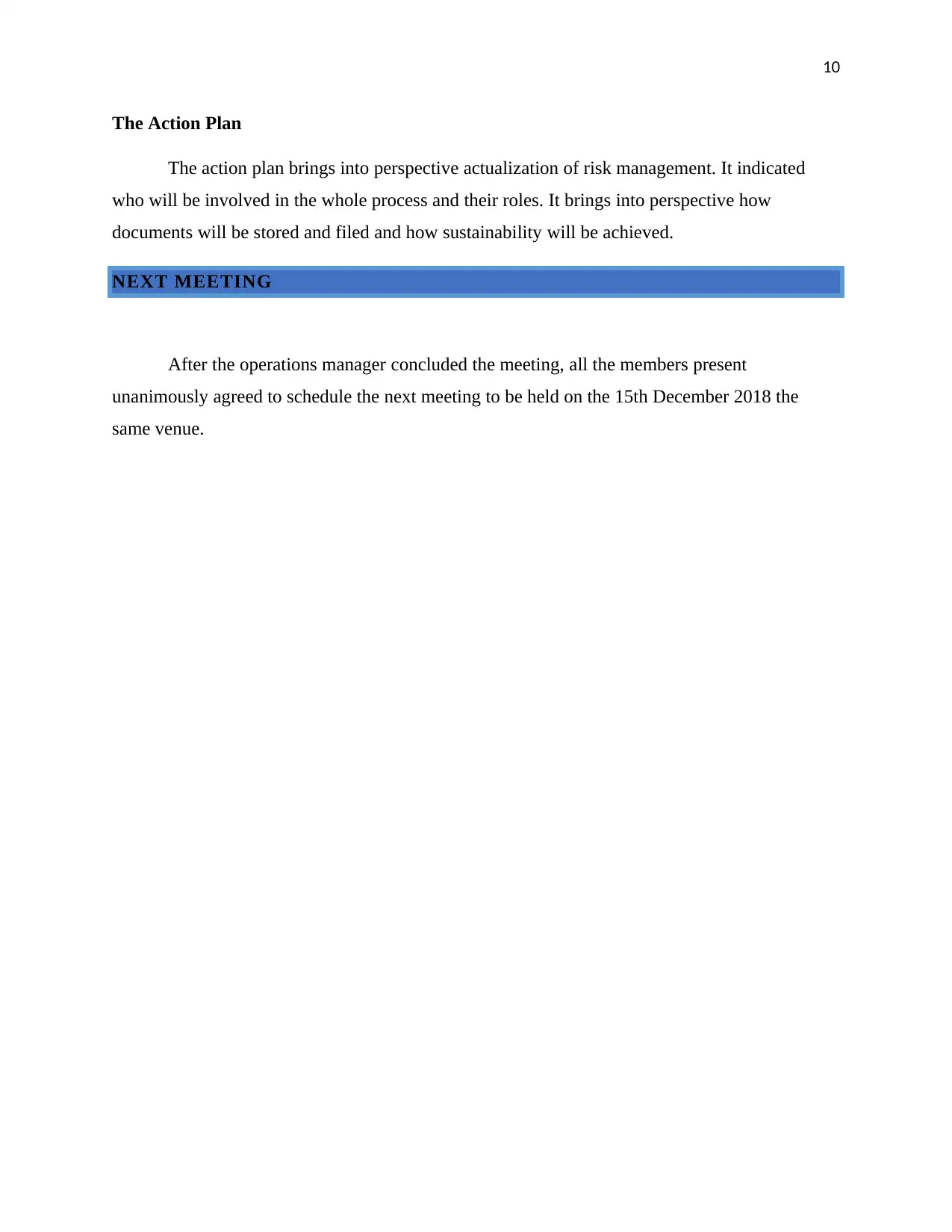
10
The Action Plan
The action plan brings into perspective actualization of risk management. It indicated
who will be involved in the whole process and their roles. It brings into perspective how
documents will be stored and filed and how sustainability will be achieved.
NEXT MEETING
After the operations manager concluded the meeting, all the members present
unanimously agreed to schedule the next meeting to be held on the 15th December 2018 the
same venue.
The Action Plan
The action plan brings into perspective actualization of risk management. It indicated
who will be involved in the whole process and their roles. It brings into perspective how
documents will be stored and filed and how sustainability will be achieved.
NEXT MEETING
After the operations manager concluded the meeting, all the members present
unanimously agreed to schedule the next meeting to be held on the 15th December 2018 the
same venue.
Paraphrase This Document
Need a fresh take? Get an instant paraphrase of this document with our AI Paraphraser
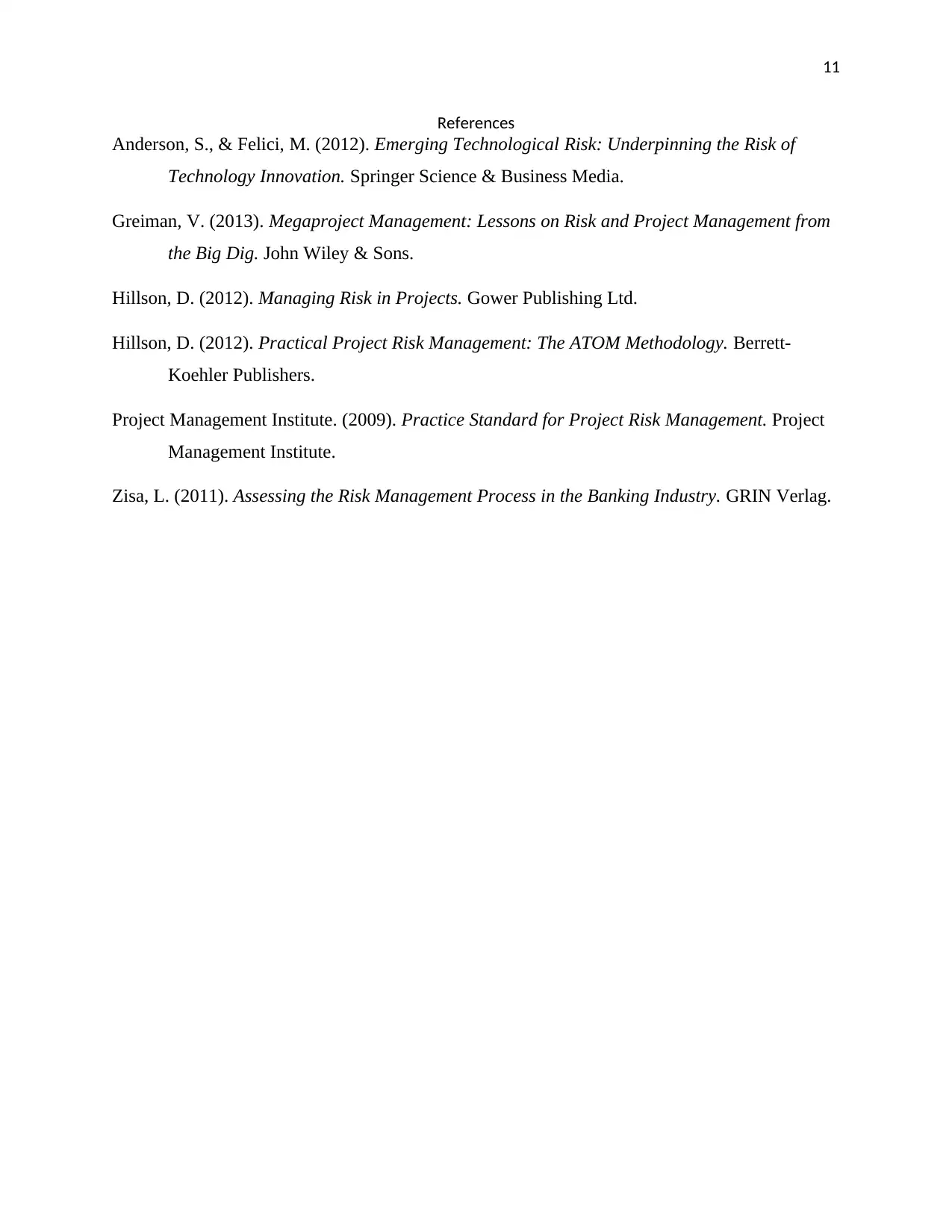
11
References
Anderson, S., & Felici, M. (2012). Emerging Technological Risk: Underpinning the Risk of
Technology Innovation. Springer Science & Business Media.
Greiman, V. (2013). Megaproject Management: Lessons on Risk and Project Management from
the Big Dig. John Wiley & Sons.
Hillson, D. (2012). Managing Risk in Projects. Gower Publishing Ltd.
Hillson, D. (2012). Practical Project Risk Management: The ATOM Methodology. Berrett-
Koehler Publishers.
Project Management Institute. (2009). Practice Standard for Project Risk Management. Project
Management Institute.
Zisa, L. (2011). Assessing the Risk Management Process in the Banking Industry. GRIN Verlag.
References
Anderson, S., & Felici, M. (2012). Emerging Technological Risk: Underpinning the Risk of
Technology Innovation. Springer Science & Business Media.
Greiman, V. (2013). Megaproject Management: Lessons on Risk and Project Management from
the Big Dig. John Wiley & Sons.
Hillson, D. (2012). Managing Risk in Projects. Gower Publishing Ltd.
Hillson, D. (2012). Practical Project Risk Management: The ATOM Methodology. Berrett-
Koehler Publishers.
Project Management Institute. (2009). Practice Standard for Project Risk Management. Project
Management Institute.
Zisa, L. (2011). Assessing the Risk Management Process in the Banking Industry. GRIN Verlag.
1 out of 11
Your All-in-One AI-Powered Toolkit for Academic Success.
+13062052269
info@desklib.com
Available 24*7 on WhatsApp / Email
![[object Object]](/_next/static/media/star-bottom.7253800d.svg)
Unlock your academic potential
Copyright © 2020–2025 A2Z Services. All Rights Reserved. Developed and managed by ZUCOL.